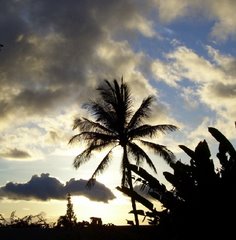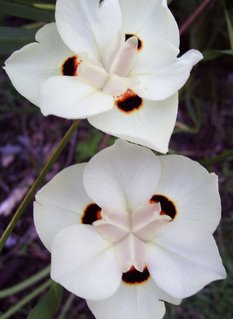One Voice in the Middle of the Pacific Ocean
The Skies of Maui

About the Former Me
A Landscape Gardener and Designer on Maui for twenty years. This blog is now an archive of the past. I have left the island.
Blog Archive
-
▼
2007
(148)
- ► April 2007 (24)
- ► March 2007 (27)
-
▼
February 2007
(34)
- Yellow Aloe by Flash Light
- Bareroot Heliconia
- Drama Rolls Downhill
- Some Sunday Morning Flowers
- Plate Lunch for Dinner
- I Wonder
- Neodypsis decaryi and Loud Bees
- Another Day is Done
- My Desktop Image is the Future
- Say Goodbye to Agapanthus
- Underneath the Landscape Fabric
- Other Pleasures
- Caught In The Act
- Clusia rosea
- Speaking of Garden Porn
- Home Made Heiau
- One Leaf
- After the Useless Rocks are Moved
- Under The Buttercup Tree
- More Rocks
- Double Feature Creature Show
- Mustache Rainbow
- Enter Here
- I Switched
- Dr. Leda Prunes Her Roses
- Three Field Mice
- Tunnels Lines and Composite Balls
- VogSet
- It's This Big
- Got Bromeliads?
- African Iris on a Different Day
- Wild Basil and Buzzing Bees
- Red Amaryllis and Black Taro
- Two Views from Today
- ► January 2007 (37)
-
►
2006
(133)
- ► December 2006 (27)
- ► November 2006 (19)
- ► October 2006 (17)
- ► September 2006 (10)
- ► August 2006 (8)
- ► April 2006 (7)
- ► March 2006 (5)
- ► February 2006 (7)
- ► January 2006 (5)
Blogroll
Tags
- Art (3)
- Buttercup (7)
- closeups (16)
- Creatures (14)
- Flowers (35)
- Gardens (11)
- Hawaii (8)
- landscapes (19)
- Light (2)
- Nursery (4)
- Plants (18)
- Short Story (13)
- Sky (18)
- Tangents (12)
- Wild Nature (15)
The Sights and Senses from One Garden on an Island in the Middle of the Pacific Ocean



9 comments:
Mine have been all leaves so far - how I hope they'll bloom this year, so I can see these shapes up close!
Annie
They do look white. Mine are always pale yellow.
I like this plant's shape and sturdiness, but I have one that, after four or five years, is looking a bit tired. The center is dying, the edges are ragged. I may dig it up and divide it, or I may take it out entirely and try something new.
It was the late evening light that made them appear almost white in the picture. They are pale yellow.
Like most sturdy clumping perennials they benefit from division when they start to get too thick. A delaying tactic to division is to mow them to the ground like grass and they come back all fresh with new growth.
So that's Dietes bicolor? Sorry to be so lame, but I 'm not very good with the common names.
Yes this is Dietes bicolor as opposed to Dietes vegeta which has a more white and blue color arrangement of the flower. Better to be lame with common names than the botanical ones.
Such shocking light -- these flowers are so overwhelmingly cream-colored here.
They are definitely vigorous (here): I saw someone "pruning" these this summer with hedge clippers. Division is a much better idea, Pam.
Anyway, I looked up Dietes, recalling some kind of taxonomic hijinks, and found that your D. vegeta is really a Moraea, at least according to wikipedia.
I believe the Dietes was formerly known as Moraea. Hortus Third refers you back to Dietes under Moraea bicolor and vegeta
I am dividing all of mine. My only problem with this plant is the brown leaves it has. What can you do to keep the brown leaves to a minimum? What fertilizer do you use on them?
The older leaves will turn brown naturally and can just be pulled off by pulling the leaf in the opposite direction of the growing point if they bug you. In a healthy clump they shouldn't be that noticeable.
If they have a large amount of brown then the clump is old and needs to be divided or you may have a pest problem or a cultural practice problem.
African Iris can get scale and whitefly which can cause leaf damage. A damaged leaf will not turn green again. Only new growth minus the bugs will make them look fresh again. That is when removing all the old leaves down to an inch above the rhizome will work plus pest control.
They need a moisture retentive soil. If they dry out or get stong winds with roots that are too dry the edges and tips can burn and turn brown. Add compost and mulch to the soil.
Any basic flowering plant fertilizer is fine in a 1-2-2 ratio. Fertilizing twice a year is plenty.
Fertilizer is not the solution to your brown leaf problem.
Post a Comment